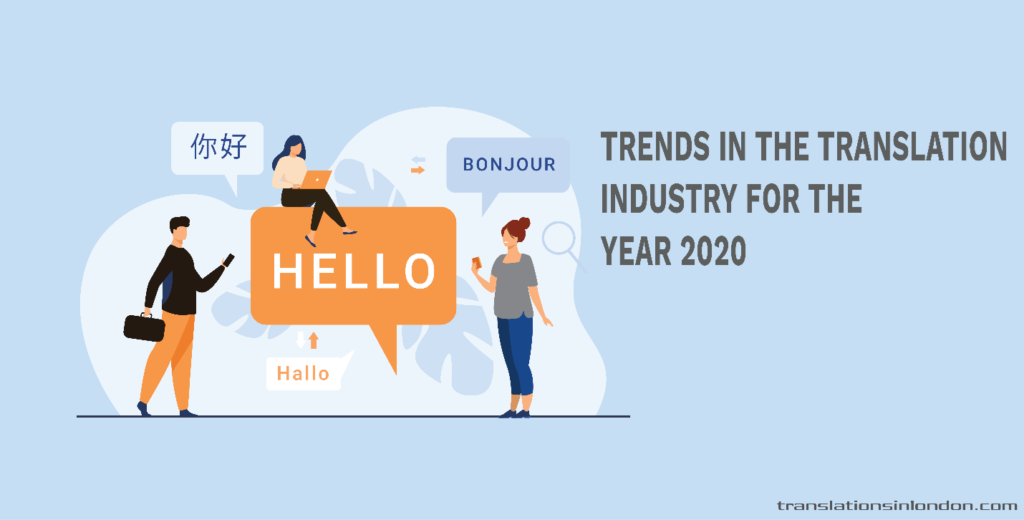With lots of anticipation and aspirations going into the new decade (2020), coronavirus burst into the scene as a significant disruptor. Just like many other sectors, the translation industry also felt the effects of the pandemic. A pandemic that has brought about novel ways of doing business and carrying out work-related responsibilities.
For our final post of the calendar year, we look back at some trends of the translation industry in 2020.

Translation industry overview
Over the last ten years, the global language service market had witnessed significant growth, doubling its size to reach $49.6 billion in 2019. In the same year, a smaller segment that is the translation and interpretation industry in the U.S alone recorded $4.401 billion in revenue, the highest ever recorded in a single year.
With the emergence of the pandemic, global lockdowns, and travel restrictions, the global economy took a hit, with several nation’s GDP shrinking by record levels. The translation industry was also affected, as the U.S translation and interpretation sector lost over $200 million in revenue in 2020, according to data from Statista.
The restrictions of movements globally gave rise to the adoption of virtual events
Many businesses, for several reasons, are turning to virtual events despite its limitation for in-person networking as a viable option to connect with their diverse audience. The rise in virtual events adoption stems from its cost-friendly nature and the ease of reaching out to a broader base from the viewpoint of businesses, it also offers brands the opportunity to provide personalized experiences to their audience.
Virtual events have spurred the demand for interpreters who are now required to cater to live-streamed programs targeted at foreign participants in order to overcome language barriers. Translators are also not left out as subtitles, Q&A’s, surveys, etc., all need translations in a bid to improve the level of interaction and engagement with foreign participants.
<a href=’https://www.freepik.com/vectors/people’>People vector created by freepik – www.freepik.com</a>
Translations companies are gravitating towards Post-editing machine translation.
The pandemic has resulted in translation companies reassessing their priorities. In a bid to deliver a more efficient, faster, and cost-friendly service, we have a trend of LSP’s increasingly exploring the option of MTPE (machine translation post-editing) in their operations. Data from the European language industry survey of 2020 backs the trend as 78% of LSP’s indicate that they want to either start or increase their use of MTPE in 2020. Although there are specific guidelines that LSP’s should focus on when adopting MTPE.
Clearly, advances in AI and Machine translation technology are promoting a broader application for MTPE, but it worthy to note its use is still not practically applicable in the translation of sensitive fields like medical translation that require a high degree of accuracy.
Medical translation and other segments going mainstream
While other sectors like the hospitality and travel segment of the translation industry are experiencing difficult times, professional medical translation services are having a field day.
We shared TIL’s own experience in our tenth-anniversary post.
Medical needs, despite being fundamentally the same are now faced with unprecedented demands due to the pandemic.
This year has witnessed a surge in demand for telemedical and interpretation services in order to provide quality healthcare and accurate diagnostics.
On the other hand, the translation of medical documents from clinical trials and the likes is on the rise as the race to develop a vaccine for the coronavirus gets to its final stages, pharma companies and research groups all around the world are collectively overcoming language barriers to validate research breakthroughs.
E-learning and other trends
The translation industry has profited from the growing adoption of e-learning platforms as against the conventional live-training system. Most organizations prefer e-Learning as it is a better value for money, especially when it involves the training of numerous personnel and a culturally diverse work-force. With the global e-learning industry predicted to reach a whopping $499.1 billion by 2020, it becomes a no-brainer for translation companies to tap into the opportunities that are present in e-Learning. When it comes to the trend of remote work culture, the translation industry does not really experience much of a change as many translators are already accustomed to working from home, TranslationsInLondon’s translator Kate Kravchenko confirms this in one of our previous interview posts.
2020, for the translation industry, has been characterized by parallels on many fronts due to the pandemic. Unfortunately, 2021 does not seem different either as the vaccine rollout is coinciding with a more aggressive second wave of the pandemic. The coming year is already shaping up to have some degree of uncertainty.
During these uncertain times, what you require is a reliable language service provider that is capable and understands the diverse needs of businesses. Translationsinlondon is just a phone call or mail away
From all of us at Translationsinlondon, we wish all our customers and readers a healthy and prosperous new year.